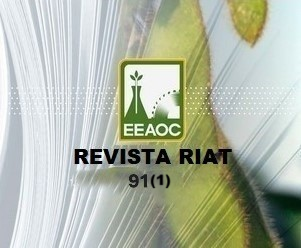Predicción de la época de floración utilizando los datos de duración del día en 11 localidades elegidas
Palabras clave:
Salvia hispanica L., chia, flowering, photoperiod, length of day, chía, floración, foto-período, duración del díaResumen
Chia (Salvia hispanica L.) is an annual herb of the Lamiaceae family. In pre-Columbian times, its seeds were one of the basic foods of Central American civilizations. Recently, chia seed has been given an important role in human health and nutrition, because its v-3 fatty acid content promotes beneficial health effects. Efforts to incorporate chia into modern agriculture only began in 1990. However, a number of chia plantations have failed lately in Northwestern Argentina, Southeast Bolivia and South Paraguay, because the fact that chia shows a short-day response to flowering and is not a frost-resistant plant has been overlooked. This technical note aims to determine the photoperiod needed for chia flowering, apart from predicting its flowering season when there are not any chia production records. The results collectively indicate a relatively narrow set of conditions for optimal chia flowering, with optimal flowering considered to be the case of fast-developing plants with many flower buds and a satisfactory height. Chia plants were only able to flower when day length was shorter than 12:27 hours. This suggests a critical day length that ranges between 12 and 13 hours.
RESUMEN
Predicción de la época de floración utilizando los datos de duración del día en 11 localidades elegidas
La chía (Salvia hispanica L.) es una hierba anual de la familia Lamiaceae. En tiempos precolombinos, la semilla de chía era uno de los alimentos básicos de las civilizaciones centroamericanas.
Recientemente, las semillas de chía han adquirido un rol importante en la salud humana y la nutrición debido a que su contenido de ácidos grasos omega-3 produce efectos benéficos para la salud. Los esfuerzos para incorporar la chía a la agricultura moderna empezaron en 1990. Últimamente, sin embargo, algunas plantaciones de chía fracasaron en el noroeste de la Argentina, sudeste de Bolivia y sur de Paraguay, debido a que se ignoró el hecho de que con días cortos, la chía muestra una escasa respuesta a la floración y no es una planta resistente a las heladas. Esta nota técnica apunta a determinar el foto-período que necesita la chía para florecer y a predecir la época de floración, cuando no hay disponibles registros de producción de este cultivo. En conjunto, los resultados indican que son relativamente escasas las condiciones necesarias para que la planta de chía alcance una floración óptima, entendida como un rápido desarrollo de las plantas, una altura satisfactoria de estas y la emergencia de muchos pimpollos florales. Las plantas de chía solo pudieron florecer cuando la duración del día fue inferior a las 12:27 horas, lo que sugiere que la duración crítica del día oscila entre las 12 y 13 horas.
Descargas
Citas
Ayerza (h.), R. 1995. Oil content and fatty acid composition of chia (Salvia hispanica L.) from five Northwestern locations in Argentina. J. Am. Oil Chem. Soc. 72 (9):971-1090.
Ayerza (h.), R. 2009. The seed's protein and oil content, fatty acid composition, and growing cycle length of a single genotype of chia (Salvia hispanica L.) as affected by environmental factors. J. Oleo Sci. 58 (7):347-354.
Ayerza (h.), R. and W. Coates. 1996. New industrial crops: Northwestern Argentina Regional Project. In: J. J. Janick (ed.), Progress in New Crops, ASHS Press, Alexandria, Virginia, pp. 46-51.
Ayerza (h.), R. and W. Coates. 2005a. Chia: rediscovering a forgotten crop of the Aztecs. The University of Arizona Press, Tucson, USA.
Ayerza (h.), R. and W. Coates. 2005b. Effect of ground chia seed and chia oil on plasma total cholesterol, LDL, HDL, triglyceride content, and fatty acid composition when fed to rats. Nutr. Res. 11:995–1003.
Battey, N. H. and R. F. Lyndon. 1990. Reversion of flowering. Bot. Rev. 56: 162–189.
Bernier, G. 1988. The control of floral evocation and morphogenesis. Annu. Rev. Plant Physiol. and Plant Mol. Biol. 39: 175–219.
Coates, W. and R. Ayerza (h.). 1996. Production potential of chia in Northwestern Argentina. Ind. Crops Prod. 3:229–233.
Naval Observatory. 2012. Duration of daylight/darkness, table for one year: locations worldwide. Government of USA. [On line]. Available from http://www.usno.navy.mil (accessed May 7, 2007).
Sahagun, B. 1579. Historia general de las cosas de Nueva España. Ediciones de AM Garibay, 1989. Editorial Porrua, México D.F., México.
Vuksan, V.; D. Whitham; J. L. Sievenpiper; A. L. Jenkins; A. Rogovik; R. P. Bazinet; E. Vidgen and A. Hanna. 2007. Supplementation of conventional therapy with the novel grain Salba (Salvia hispanica L.) improves major and emerging cardiovascular risk factors in type 2 diabetes. Diabetes Care 11:2011–2804.
Wang, Z.; V. R. Reddy and B. Quebedeaux. 1997. Growth and photosynthetic responses of soybean to short-term cold temperature. Environ. Exp. Bot. 37:13–24.
Descargas
Publicado
Cómo citar
Licencia
Derechos de autor 2014 Ayerza

Esta obra está bajo una licencia internacional Creative Commons Atribución-NoComercial-CompartirIgual 4.0.






